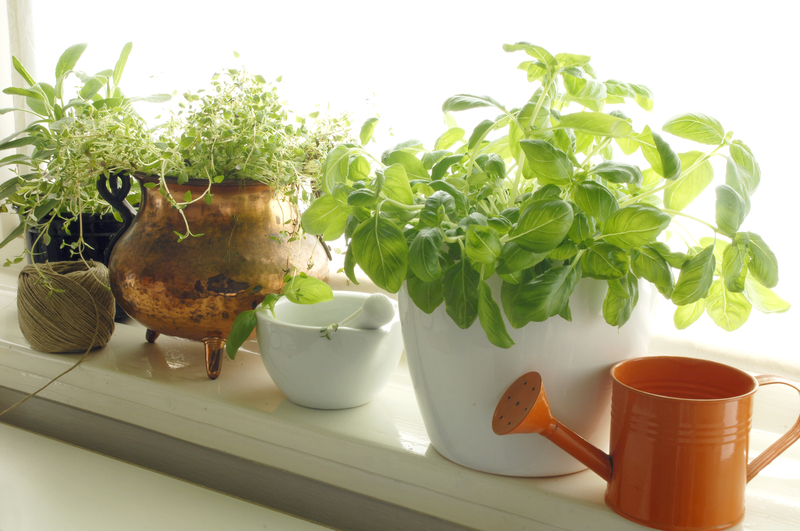Harvest Your Potential: 9 Crucial Tips for First-Time Gardeners
Posted on 03/07/2025
Harvest Your Potential: 9 Crucial Tips for First-Time Gardeners
Gardening is more than just a hobby; it's a rewarding activity that brings beauty, flavor, and tranquility into your life. Whether you dream of vibrant flowers, lush vegetables, or a few cheerful herbs on your balcony, beginner gardeners have so much potential to transform a simple patch of earth into a personal paradise. In this comprehensive guide, we'll walk you through nine essential tips that will help you harvest your potential and set you up for gardening success. Whether you're planting your first seed or nurturing your first sprouts, these expert insights will ensure your gardening journey is off to a thriving start.
Why Start Gardening?
Before we delve into the nine tips for first-time gardeners, it's important to understand the benefits of gardening. Cultivating your own garden provides:
- Fresh, healthy produce grown right at home
- Physical activity that promotes well-being
- Mental relief and stress reduction through time spent in nature
- A sense of accomplishment and pride
- Increased knowledge about plants and sustainability
No matter your reason for starting, these gardening tips will help you nurture your green thumb and make the most of your potential harvest.

9 Essential Gardening Tips for Beginners
1. Start Small and Simple
For many first-time gardeners, the temptation is to start big. However, resist the urge to plant too much too soon. Begin with a manageable plot or a few containers. This approach allows you to focus on learning and reduces overwhelm. Even a few pots of herbs or salad greens on your windowsill can be incredibly rewarding for beginner gardening enthusiasts.
- Choose 3-5 easy-to-grow plants like basil, lettuce, and tomatoes
- Observe how much time you realistically have for tending your garden
- Expand your garden as your skills and confidence grow
2. Pick the Right Location
Sunlight is a key ingredient for gardening success. The majority of vegetables and flowers thrive in locations that receive at least 6-8 hours of direct sunlight daily. Scope out your space at different times to observe sun and shade patterns. If you're gardening indoors or on a balcony, select a spot near a bright, south-facing window.
- Note which direction your garden or containers face
- Look for protection from strong wind (especially for delicate or tall plants)
- Ensure your water source is nearby for easy irrigation
3. Understand Your Soil
Healthy gardens start with healthy soil. Garden soil provides the nutrients, structure, and drainage your plants need to flourish. As a new gardener, invest in a simple soil test kit or contact your local extension office for advice.
- Test soil pH and nutrient levels to assess what amendments may be needed
- Add compost or well-rotted manure to enrich poor soil
- For container gardening, opt for high-quality potting mix
Pro tip: Avoid working wet soil, as it can compact easily and harm beneficial soil life.
4. Choose Easy Crops for Maximum Success
Selecting the right plants is one of the most important decisions for novice gardeners. Some plants naturally require less maintenance and are more forgiving of occasional mistakes. If you're just starting to discover your gardening potential, these crops are perfect choices:
- Greens: Lettuce, arugula, spinach
- Herbs: Basil, parsley, chives
- Root veggies: Radishes, carrots
- Flowering plants: Marigolds, zinnias
- Tomatoes and beans: Particularly suited for pots or small beds
Check seed packets or plant labels for specific care instructions and be sure to select varieties suited to your local climate.
5. Plan Before You Plant
Gardening is much smoother when you plan ahead. Create a planting calendar based on your region's frost dates. Map out your plot to ensure each plant has the space it needs to grow and thrive. Group taller plants where they won't shade out shorter ones, and allow climbing plants access to supports such as trellises or fences.
- List the vegetables, herbs, and flowers you want to grow
- Research when to sow seeds or transplant seedlings in your area
- Sketch a basic layout of your garden bed or container arrangement
6. Master the Art of Watering
Both over-watering and under-watering are common mistakes for first-year gardeners. The key is to water deeply and less frequently so that roots seek moisture below the surface. Water in the early morning or late afternoon to avoid rapid evaporation and reduce disease risks.
- Check soil moisture by inserting your finger about 1-2 inches deep; water only if it feels dry
- Use a soaker hose, watering can, or drip irrigation for most efficient delivery
- Avoid overhead watering to minimize fungal diseases
Remember: Different plants have different moisture needs. Get familiar with the preferences of each type you plant!
7. Feed and Mulch
Plants are hungry for nutrients just like humans. After amending your soil, maintain fertility with organic fertilizers or compost throughout the growing season. A two- to four-inch layer of mulch (such as straw, bark, or shredded leaves) will:
- Retain soil moisture
- Suppress weeds
- Moderate soil temperature
- Slow the loss of precious nutrients
Mulching is one of the easiest ways to promote healthy, robust growth while cutting down on your workload!
8. Keep an Eye Out for Pests and Diseases
Even the best-tended garden faces challenges from pests and diseases. Observation is your greatest ally. Check your plants regularly for wilting, yellowing, or holes in leaves. Most issues can be controlled early before they become a major problem.
- Attract beneficial insects like ladybugs and lacewings to manage pests naturally
- Use barriers, such as row covers, to protect seedlings
- Clean up plant debris and weeds that harbor disease
- Apply organic or natural remedies as needed
A healthy, diverse garden is the best defense for first-time gardeners.
9. Be Patient and Learn from Experience
Perhaps the most crucial gardening advice for beginners is to be patient and savor the learning journey. Every new gardener encounters challenges, but each season brings fresh opportunities for growth--both for you and your plants. Document your progress with a garden journal so you can remember which crops excelled, which pests visited, and what you'll try differently next time.
- Take photos to track before-and-after progress
- Engage with local gardeners or online communities for support
- Celebrate successes, no matter how small!
Bonus: Common Questions from First-Time Gardeners
How do I know when to harvest my crops?
Read seed packets and plant tags, as each crop has unique signs of maturity. For greens, harvest the outer leaves as they reach edible size. For fruits and root vegetables, color and firmness are key indicators. Frequent harvesting promotes more growth and yields a greater harvest.
What if my plants aren't growing?
If your garden isn't thriving, check for these common first-time mistakes:
- Poor sunlight exposure
- Incorrect watering (too much or too little)
- Lack of nutrients
- Pests or disease
- Improper plant spacing

Final Thoughts: Unlock Your Green Potential
Gardening for beginners can feel overwhelming, but with these nine crucial gardening tips, you'll be well equipped to cultivate a thriving, productive, and beautiful space. Remember, every expert gardener started with a single seed--progress is just as important as perfection. Take your time, celebrate small wins, and enjoy every moment spent in the dirt.
Ready to harvest your potential? With planning, patience, and a passion for growth, your very first garden can provide a lifetime of rewards. Here's to many seasons of success--let your gardening adventure begin!
Further Reading and Resources
Start your gardening journey today and unlock the joys of your own edible oasis. Remember, the best time to plant a garden was yesterday--the next best time is now!

